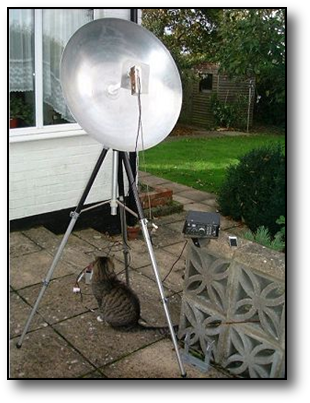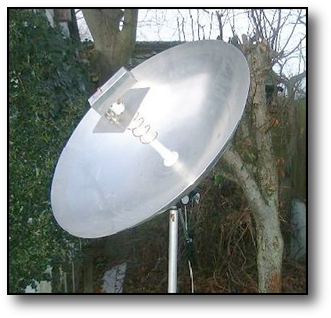Oscar 40 Operation
To operate through the nominally geostationary satellite Oscar 40, the following equipment was used.
For the L band uplink a 1.1m mesh dish was used, shown above equipped in its "earlier life" with a Meteosat feed, but for Oscar 40 operation a helix feed was used. A 3 band feed was also constructed, but Oscar 40 ceased operation before this could be tried. However preliminary tests indicated that using this dish for reception too produced an excellent downlink signal, althought there may be transmit-to-receive isolation issues to address.
RF power was produce by a homebrewed 1269MHz converter driven by a 145MHz IF. This produced an output of 1W pep on SSB, which was then used to drive a single cavity 2C39A PA to 50-60W output. A very respectable signal was produced using this set up, and while the satellite was at apogee the dish only needed the occasional manual "nudge" to ensure the signal level was maintained, thus no automatic tracking was used.
The dish was made from a kit, long ago supplied by LMW Electronics and comprised the shaped aluminium ribs, welded hub and wire rim. The only extra parts the builder had to supply was some suitable wire mesh, the feed tripod and aluminium solder.
Unfortunately Oscar 40 suffered battery failure some years ago and thus operation ceased. However the equipment is being kept for the next semi-geo satellite due for launch whenever that may be.
For the L band uplink a 1.1m mesh dish was used, shown above equipped in its "earlier life" with a Meteosat feed, but for Oscar 40 operation a helix feed was used. A 3 band feed was also constructed, but Oscar 40 ceased operation before this could be tried. However preliminary tests indicated that using this dish for reception too produced an excellent downlink signal, althought there may be transmit-to-receive isolation issues to address.
RF power was produce by a homebrewed 1269MHz converter driven by a 145MHz IF. This produced an output of 1W pep on SSB, which was then used to drive a single cavity 2C39A PA to 50-60W output. A very respectable signal was produced using this set up, and while the satellite was at apogee the dish only needed the occasional manual "nudge" to ensure the signal level was maintained, thus no automatic tracking was used.
The dish was made from a kit, long ago supplied by LMW Electronics and comprised the shaped aluminium ribs, welded hub and wire rim. The only extra parts the builder had to supply was some suitable wire mesh, the feed tripod and aluminium solder.
Unfortunately Oscar 40 suffered battery failure some years ago and thus operation ceased. However the equipment is being kept for the next semi-geo satellite due for launch whenever that may be.
A 60cms G3RUH dish with a helix feed, and a G4DDK homebrewed downconverter were used here to receive the 2401.3Mhz downlink signals. The latter was located adjacent to the feed to minimise the impact on the noise figure and had a 144Mhz IF. Good signals were heard on this set-up, although with the increasing use of 2400MHz for WiFi some interference was experienced on some dish headings.


